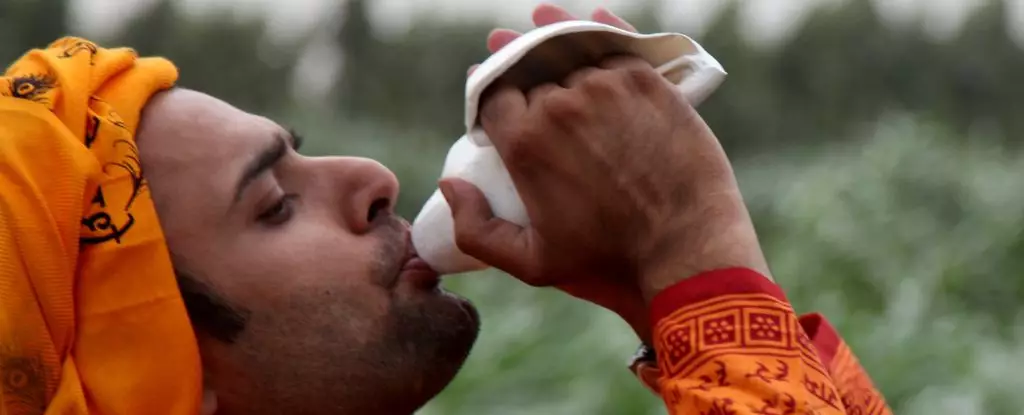In a world saturated with technological solutions, it is remarkably inspiring to find ancient, simple practices emerging as promising avenues for health improvement. The practice of consciously engaging in prolonged, controlled exhalations—found in traditions such as Indian shankh (conch shell) blowing—raises compelling questions about how natural methods can enhance respiratory health. Recent research, though preliminary, suggests that these age-old techniques could serve as powerful tools against obstructive sleep apnea (OSA), a pervasive and often debilitating condition affecting nearly a billion adults globally. This intersection of tradition and science opens the door to non-invasive, accessible alternatives that challenge our reliance on machines like CPAP.
The concept that intentional breathing exercises might fortify the muscles around our airway is both elegant and refreshing. While conventional treatments like continuous positive airway pressure machines have proven efficacy, their usability issues hinder long-term compliance. As a critical advocate for innovative, patient-centered care, I believe exploring natural methods could revolutionize how we approach sleep disorders, especially for those who find technological devices uncomfortable or burdensome. The idea that blowing into a conch shell—a ritualistic and meditative act—might help keep the airway open during restful slumber exemplifies the potential complexity behind simple actions.
Ancient Wisdom Meets Scientific Inquiry
The recent clinical trial exemplifies a thoughtful effort to scientifically evaluate traditional practices. Involving individuals with moderate OSA, the study compared the impact of shankh blowing to deep nasal breathing. Participants dedicated fifteen minutes, five days a week, to practicing this technique—an amount that seems manageable and realistic for most busy individuals. The results? An impressive improvement characterized by fewer apneas, increased oxygen saturation, and greater daytime alertness.
Delving deeper into why this method may work, it’s plausible that the activity enhances the strength and resilience of the upper airway muscles. The technique’s distinctive deep inhale followed by a forceful, sustained exhalation creates vibrations and airflow resistance, effectively training muscles that tend to collapse during sleep. This is reminiscent of physical exercises for other muscles—strengthening and toning to improve function. If these findings are validated on a larger scale, they could herald a paradigm shift—transforming the way we view sleep health, emphasizing empowerment over dependence on external devices.
However, it’s critical to remain cautious. The trial’s size was limited, and its methodology lacked blinding, which can influence the outcomes. Scientific rigor demands broader, more rigorous investigations before these findings can be universally accepted. Yet, the potential here is undeniable. As someone who appreciates holistic approaches, I see this as an exciting bridge between traditional practices and evidence-based medicine, capable of inspiring more comprehensive, integrative health strategies.
Reimagining Sleep Therapy Through Cultural and Biological Insights
What stands out most about this research is its emphasis on the body’s innate capacity for self-healing. Breathing techniques rooted in yoga and Indian spiritual practices have long emphasized the importance of mindful breath control for mental clarity and physical vitality. The physiological effects—such as strengthened airway muscles and improved oxygenation—align seamlessly with these ancient philosophies, suggesting that our ancestors intuitively understood the power of breath.
In the broader scope, this approach challenges the often limited perspective of conventional sleep medicine. It advocates for a more personalized, less invasive pathway toward health restoration—one rooted in the individual’s ability to harness their own physiology. It also raises intriguing questions about how other age-old practices, such as pranayama or Tibetan breathing techniques, might similarly impact sleep quality and respiratory health.
Furthermore, adopting such methods could democratize treatment, making effective care accessible to diverse populations regardless of healthcare infrastructure or affordability. The potential for low-cost, portable, and non-pharmacological interventions could be transformative, especially in underserved regions where sleep disorder treatments are scarce.
—
This exploration into the potential of ancient breathing practices underscores an essential truth: sometimes, the most profound health solutions are hidden within our history and tradition. If validated through larger and more rigorous studies, simple acts like conch blowing could become integral parts of holistic approaches for sleep health—empowering individuals to take control of their breathing and well-being without relying solely on technological fixes.

